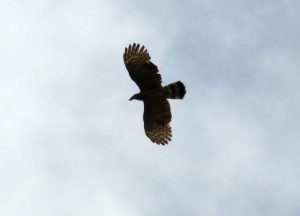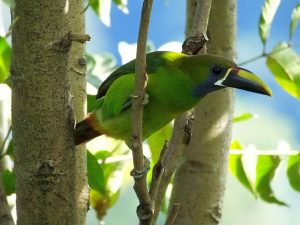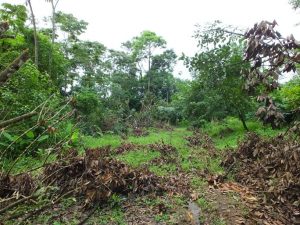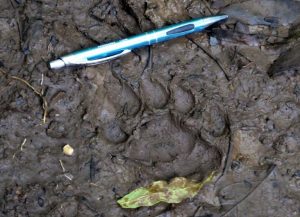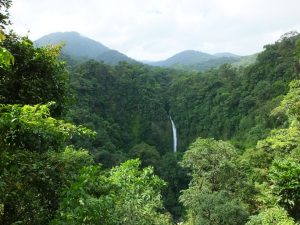The end of the year is nigh but there are more birds to see. What’s a birder with a year list to do but check eBird, keep an eye on the local rare bird alerts, and get out there before the end of the 31st? For a disciplined birder faithful to the year list, the logical solution is racing around and getting in those last, final birds. But, disciplined or not, if the holidays get in the way, or family responsibilities come into play, we might have to settle on a year list total some days before the 31st. Such is my case but I won’t complain. I’ve had a wonderful year of birding, walked past my initial goal of 600 species in Costa Rica way back in spring, and hit 650 some time ago. Recently, I also hit 675, and if I had time to head to Guanacaste, Tapanti, and a couple other sites, I’m satisfied knowing that I would break 680.
Therein lies one of the big benefits of looking for birds in a mega biodiverse country and an easy mantra for birding Costa Rica- do more birding, identify more species. With over 800 possibilities, it kind of never ends as long as you keep hitting different habitats and bioregions, and by the end of the year, there are always some species still missing from the list. Unless I see them outside my window or happen to get in a final day or two of birding in the right places, a dozen of my biggest misses will include the following:
Hook-billed Kite– It’s not common but it’s not rare so this one is probably my biggest miss of the year. It can turn up in all sorts of places, some of the most likely being the Orosi area, and wetland/riparian zones in Guanacaste. I still have a slim hope that one might be soaring up there near the house while I look out the window but some serious lady birding luck would have to be in the cards for that to happen. I’ll keep looking though, because “she” has paid unexpected visits right out the window on more than one occasion. As for other raptors, I did pretty good, getting the hawk-eagle trifecta, Tiny Hawk, Bicolored, Hawk, Crane Hawk, and 27 other diurnal species. To give an idea of raptor diversity in Costa Rica, that nice total still leaves out Cooper’s, Sharpie, Snail Kite, Black-collared Hawk, the three mega rare eagles (that would be Harpy, Crested, and Solitary), and three other species on the country list.
A Hook-billed Kite from another year.
Blue-footed Booby– It’s irregular but I usually see it at some point, and since I had seen several the previous year, I figured this one was in the bag. Another ride on the ferry or more scope time from shore would probably work.
One of several from the ferry in 2015.
Sunbittern– I was going to say Agami Heron but since that species is pretty uncommon and tough, I can’t really say that it falls into the “Big Miss” category. I had one main chance to get it while visiting Laguna del Lagarto almost a year ago but, for whatever reason, the fancy heron wasn’t showing up where it usually does. As for the Sunbittern, Yeah, I should have seen that oen at some point! I sure looked at enough suitable rivers for it. If you need it, the most reliable spot is probably the rivers near Rancho Naturalista.
Sungrebe– Yep, I also missed the other “sun” bird! Since I didn’t do any boat trips in Cano Negro or Tortuguero, no surprise there. I still hoped to chance upon one while checking lagoons in other places but oh well, no Sungrebe for me in 2016.
One from another time at Tortuguero.
Gray-headed Dove– I had hoped to at least hear one during an afternoon at Cano Negro village but didn’t so there went my main chance for this uncommon species. I made up for it though with hearing the rarer Violaceous Quail-Dove at Hitoy Cerere!
Common Nighthawk– Some birds have “common” in their name but aren’t so common. In Costa Rica, this one should be known as the “Locally and Seasonally Common Nighthawk”. It’s a passage migrant in large numbers on the Caribbean coast and is a resident in a few other places. Because of this, I figured it was a given during spring and fall visits near Cahuita but nope, no Common Nighthawks!
Green-fronted Lancebill– This stream loving hummingbird is easy to miss (I might still get it) but if you spend enough time at Tapanti, Monteverde, and streams with waterfalls in cloud forest, you have a fair chance. I did really good for hummingbirds in general however seeing all other regular species and lifering the Rufous-crested Coquette at Rancho Naturalista!
If I head to the mountains, might still get one of these.
Yellow-bellied Sapsucker– I know, not so exciting for birders from up north but I usually see one or two of this uncommon migrant during the year. Still might get it but the time is ticking down for this one.
Merlin– Pretty much the same story as the sapsucker. I actually probably did see one while driving through Cartago but the looks were just too brief to call it for the year list.
Tawny-throated Leaftosser– If I can head out tomorrow, might still get it! Really surprised, though, to not at least hear it while birding at more than one good site for it during the year.
White-throated Flycatcher– Somehow missed this uncommon one too. I looked for it a few times in the right places but should have looked more.
I hope 2016 treated you well in terms of birds, birding, dark organic chocolate, and all other things good in life!

